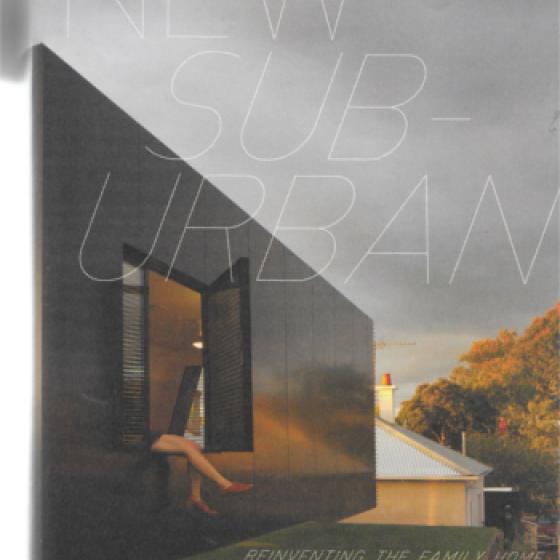Title: New Suburban: Reinventing the family home, Australia and New Zealand
Author/s: Stuart Harrison
Editing: Nab McNab
Design: Chase and Galley
Photographer/s: Andrews, Emily; Bennetts, Peter; Boardman, Brett; Cross, Emma; Frith, Robert; Gollings, John; Granleese, Nic; Honeysett, Ross; Jungbeck, Nina; Knowler, James; Lauthier, Erica; Linkins, Jon; McGrath, Shannon; Noonan, Sam; Rethmeier, Willem; Reynolds, Patrick; Rodriguez, Patrick; Roe, Tom; Scott, Toby; Taylor, Alicia; Wood, Simon.
ISBN: 978-050050-039-2
Size: 204mm by 282mm, 344p.
Date Published: 2013
Publisher: Thames & Hudson www.thameshudson.com

Looking at contemporary examples of how traditional suburban houses have been reinvented, revised and renovated in Australia and New Zealand, New Suburban is the second book from Stuart Harrison and complements his first, Forty-six Square Meters of Land Doesn’t Normally Become a House. New Suburban is in particular a well-crafted book, with a highly interesting colophon that explains the book’s design choices.
As the name suggests, the previous book from Harrison examined houses built on small and/or narrow parcels of land which rarely included a large outdoor area. While the houses in New Suburban are much larger, their designs are just as finely honed. A high emphasis is put on the garden space in particular, as of all of the qualities that families look for in a typical suburban house it is the ability to use the exterior, mainly for children, that is most sought after.
The houses that Harrison inspects in this book are all family-focused, have multiple bedrooms and comfortable amounts of outdoor space, as would be expected of a typical suburban house. However, Harrison is not looking for houses that do not push the boundaries of design, instead focussing on newer constructions that highlight the changes in how our families are made up, the changes in the requirements of housing codes and the changes in our modern cities.
New Suburban is divided into three sections; Return to the Suburbs, Remaking for Family Life and The Suburban Remade. The first section looks at typical suburban homes located in regular suburbs. However, these houses take a modern viewpoint of what the purpose of suburbia is when it comes to how a house is designed. Remaking for Family Life deals with renovations and restorations of houses that, while originally typical suburban properties, have now been updated to better serve in a modern context. The final section takes houses that, while not located in the suburbs, use the same inspirations as houses in the previous sections to create suburban spaces in inner-city locations.
All of the houses included in New Suburban contribute to the understanding of what suburbia and the houses found there mean in a contemporary context. From the first section, the Karri Loop House (54) in Margaret River, WA is a typical suburban house with extensive outdoor areas that surround it on all sides. Its uniqueness comes through in the three large trees on the property that the house winds around, attempt to affect them as little as possible, and the plywood-lined interior walls that reflects light from the courtyard throughout the home. S House (86) from Mt Eden, New Zealand is located on a smaller block but still has gardens on multiple sides, a lush area of greenery surrounding a pool and plenty of space for children to play.
The houses in the second section, as renovations and restorations, all try to balance the original spaces with the new addition to achieve a harmony between the two. The Forever House (156) from Surrey Hills, Victoria does an exceptional job of blending the old section built from clinker brinks with the newer timber framing. From a nearby suburb in Hawthorn, the Victoria Road House (202) takes a typical terrace and creates a sumptuous modern residence, with coloured glass clerestories granting a pink glow over the multi-hued plywood ceiling; possibly the finest house in the entire book.
The final section is perhaps the most interesting, with various projects of widely differing sizes. The first, the Heller Street Park and Residences (250) from Brunswick, Victoria combines, as the name suggests, a park with a bank of ten houses built in a terrace. Though all the houses share at least one party wall, their design creates multiple private outdoor spaces for each residence. This project provides an oasis for the community along with the families who live there. Also in Victoria, the Harold Street house in Middle Park rests on a smaller plot than many of the other houses in this book and has much less outdoor space, but the design draws heavily from the suburban tradition and the brick-and-stonework fits perfectly against all of the other inclusions.
New Suburban presents many houses that, while not necessarily traditional suburban residences, draw from that tradition to create spaces that achieve what the suburbs have always tried to do; make a space to raise a family with plenty of immediate outdoor access. Harrison has done a great job in collating this collection, and the book stands with his first as an excellent read for any lover of design.
